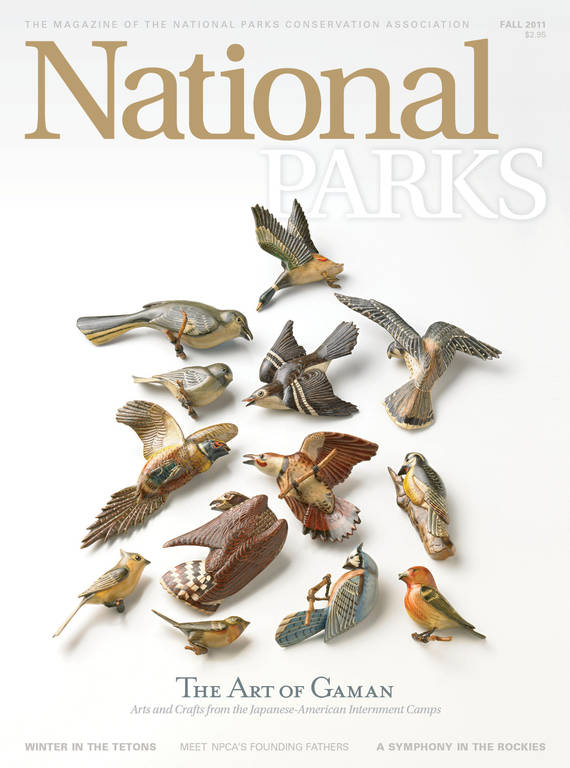Fall 2011
Out of Sync
Climate change is affecting the national parks’ most ancient and critical cycles. Can citizen science help?
A yellow warbler, wintering deep in the jungles of Central America, responds to the longer days of spring by migrating to its breeding grounds in Yellowstone National Park. A desert dandelion, coaxed through sandy soil by warm temperatures and rainfall, blooms in Mojave National Preserve. A western tiger swallowtail butterfly emerges from its cocoon to feast on nectar from mountain wildflowers blooming in Sequoia National Park.
This is phenology: the seasonal patterns of growth, development, and reproduction in plants and animals. Some of those patterns have been in place for millions of years, but recently, climate change has caused some to fall out of sync. Scientists are determined to get a better handle on those changes. “By tuning in to the patterns around us, we are able to understand a lot more about how climate change may affect the relationships between plants and animals,” says Brian Haggerty, a doctoral student studying phenology at the University of California–Santa Barbara. “If a plant flowers earlier because of an unusually warm spring, it might benefit that plant, but it might be bad for animals that depend on the flowers, fruit, or seeds if they can’t shift their timing with the plant.”
Such timing changes in the life cycles of plants are rippling across food webs. Yellow-bellied marmots, for example, have increased their weight and improved their winter survival rates, thanks to a longer plant-growing season in the Rocky Mountains. These high-elevation herbivores are emerging from hibernation earlier and are able to fatten up longer for winter. While a population increase of yellow-bellied marmots might sound like a good thing, it could have unintended consequences. “How does it affect other plants and herbivores when we look down the food web?” asks Liz Matthews, a postdoctoral associate for the California Phenology Project. The marmot boom could upset the predator-prey balance or deplete high-elevation plant resources, ultimately triggering a marmot population crash. And considering marmots’ attraction to antifreeze—which drives them to chew through car engine hoses—one has to wonder if a population increase might adversely affect national park visitors, too.
Farther west in Mojave National Preserve, the health and reproductive success of two icon species—the desert tortoise and bighorn sheep—depend on plants, which are influenced by climate. When desert tortoises emerge from their burrows in spring, they search for tender green plants and flowers. Bighorn sheep, on the other hand, consume vast quantities of green vegetation to gain weight, which helps ensure that ewes give birth to healthy lambs. A shift in climate could change the timing of the growth and reproduction of plant resources that are critical to both animals. And when individual species begin to suffer, it can put their entire ecosystem in jeopardy, too.
Debra Hughson, Mojave’s Science Advisor, compares it to the vital signs of a medical patient: “If you see a symptom in a patient that reflects poor health, you would look closer at the patient’s blood pressure, or you might conduct other tests to find out what’s wrong.” Similarly, if dramatic changes are occurring within the park’s bighorn sheep population, scientists would have to ask what those changes reflect about the health of the ecosystem to which those sheep belong. That’s why studying phenology is so valuable—it helps connects the dots.

National Parks
You can read this and other stories about history, nature, culture, art, conservation, travel, science and more in National Parks magazine. Your tax-deductible membership donation of $25 or more entitles…
See more ›But tracing the history of these ancient cycles isn’t always so easy. Although humans have kept records about the growth and reproduction of food crops for a long time—“agricultural phenology”—there are hardly any data about phenology in wilderness or national parks. The California Phenology Project (CPP), a collaboration among the National Park Service, National Phenology Network, and the University of California at Santa Barbara and Berkeley, uses “citizen science”—the act of engaging the public to assist in scientific research—to explore the life histories of plants from national parks and other wildlands. CPP is working in seven national park units in California alone: Golden Gate National Recreation Area, Joshua Tree National Park, Lassen Volcanic National Park, Santa Monica Mountains National Recreation Area, Sequoia and Kings Canyon National Parks, and Redwood National and State Parks. These units represent key California bioregions, ranging from the mountains to coasts to deserts. Citizen scientists are tasked with gathering data about the life cycles of specific plants. They will record stages of growth and development, or “phenophases,” like flowering and fruiting.
But it’s not just about numbers; their work contributes to a much bigger picture, too. “Plants are everything to people and animals,” says Angie Evenden, a lead investigator for CPP. “They provide habitat to animals, food for humans, wood for building—but we don’t know how those systems are going to be affected by climate change.”
Ultimately, CPP’s goal is to establish data that will shed more light on how climate change is disrupting natural cycles, because once scientists understand that, land managers might be able to help the more vulnerable species adapt. Relocating those species to a more hospitable environment is just one example. Until then, Sylvia Haultain, a plant ecologist studying phenology at Sequoia National Park, sees herself playing another critical role: educator. “We as Park Service managers have an obligation to detect these changing patterns and communicate what’s happening,” she says. “It’s important to be able to tell this story to the public and policymakers.”
About the author
-
 Seth Shteir Former Californian Desert Program Manager
Seth Shteir Former Californian Desert Program ManagerSeth was a Program Manager in NPCA’s California Desert Field Office from 2014 to 2017.



